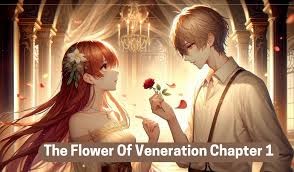
1. Introduction about The Flower of Veneration Chapter 1
In Chapter 1 of The Flower of Veneration, the flower is not just a physical object; it symbolizes growth, purity, and the potential for spiritual enlightenment. The very first pages introduce the flower as an emblem of veneration—a form of deep respect or reverence that plays a central role throughout the narrative.
Flowers, in many cultures, have long been symbols of beauty, fragility, and renewal. Here, they represent a delicate balance between life and death, blooming and wilting, light and darkness. As the protagonist encounters the flower, they are forced to confront their own beliefs, their fears, and their desires. This chapter subtly challenges the reader to reflect on their own capacity for reverence in the face of life’s complexities.
By placing such an ordinary object in the heart of the story, the flower transcends its role as mere decoration. It becomes an instrument of change, signaling the start of a profound journey both for the character and for the reader.
2. Setting the Stage: The Flower of Veneration Chapter 1
The world of The Flower of Veneration is carefully crafted, blending elements of reality with the mysticism of ancient traditions. Chapter 1 doesn’t just introduce the characters—it immerses readers in a space where culture, ritual, and nature are intertwined. Here, veneration is not simply a passive act; it is an active force that shapes the lives of those who practice it.
This world is one where respect for nature is not merely philosophical—it is a way of life. The environment, teeming with vibrant flora and fauna, mirrors the internal worlds of the characters. Through subtle world-building techniques, we understand that veneration is not confined to grand temples or religious figures; it is embedded in the smallest details of everyday life, even in the act of planting a simple flower.
3. Main Characters Introduced
Chapter 1 serves as the introduction to the story’s central figures, each of whom will play a key role in the unfolding narrative. At the heart of the chapter is the protagonist—a young, curious individual who finds themselves caught between the world of tradition and their own desire for independence.
Alongside them is a mentor-like figure who embodies the values of veneration, guiding the protagonist toward deeper understanding. This character is steeped in the wisdom of the ancients and represents the ideals of reverence and tradition that the story seeks to explore.
Each character’s journey is marked by their relationship to the flower and to the concept of veneration. The choices they make, the paths they follow, and the lessons they learn are all linked to their interactions with this symbolic flower, setting the stage for their development over the course of the story.
4. The Call to Action: A Mysterious Event
In Chapter 1, the plot thickens when an unexpected event unfolds—a mysterious occurrence that disrupts the peaceful life of the protagonist and their community. This event serves as the catalyst for the journey ahead, urging the protagonist to step outside their comfort zone and explore the deeper mysteries of their world.
The significance of this event is twofold: It forces the protagonist to reconsider their relationship with the world around them and challenges their preconceived notions about veneration. The mystery that surrounds this event—whether it’s a supernatural occurrence, a hidden truth, or a personal crisis—sets in motion the larger narrative arc that will unfold in subsequent chapters.
5. The Symbolism of Flowers in the Story
The flower plays a crucial symbolic role throughout the story, especially in Chapter 1. It is not merely a physical object but a metaphor for spiritual growth, beauty, and the passage of time. The flower in this story symbolizes both fragility and resilience—traits that mirror the journey the protagonist will undertake.
In many cultures, flowers are linked with the concept of life cycles, representing birth, growth, and death. The Flower of Veneration, in particular, becomes a symbol of personal and spiritual transformation. As the protagonist learns to understand the true nature of the flower, they are led closer to understanding their own purpose.
6. Nature’s Influence: A Spiritual Connection
Nature’s presence in Chapter 1 is profound. The story is steeped in natural imagery, from the growth of plants to the changing of the seasons. The characters’ relationships with nature are not just physical but spiritual as well. The natural world is a mirror for the inner landscapes of the characters, and through their interactions with nature, they begin to realize deeper truths about themselves.
Nature, in this chapter, is both a teacher and a guide. The flower, the central symbol of this world, becomes a bridge between the physical and spiritual realms. As the protagonist interacts with nature, they begin to develop a deeper understanding of their own inner world, setting the stage for the spiritual revelations to come.
7. Foreshadowing and Plot Development
Foreshadowing is a subtle but powerful tool used in Chapter 1. The mysterious event, the introduction of the flower, and the characters’ reactions all hint at larger conflicts and themes that will emerge in future chapters. The flower, while appearing innocent and pure, is a sign of impending change—both external and internal.
This foreshadowing is not overt; rather, it lingers in the background, prompting the reader to consider what lies ahead. It builds anticipation and keeps the reader engaged, eager to uncover the story’s mysteries as they unfold.
8. The Role of Tradition and Culture
Tradition plays a significant role in the development of the story’s themes. The protagonist’s community is deeply rooted in cultural practices that have been passed down for generations. These traditions, while rich with wisdom, sometimes come into conflict with the protagonist’s own desires for personal growth and independence.
In Chapter 1, the tension between tradition and modernity begins to surface. The protagonist is faced with a choice: Will they honor the traditions of their ancestors, or will they forge their own path? This question sets the stage for the larger conflict that will drive the narrative forward.
9. The Emotional Undertones of the First Chapter
Beneath the surface of The Flower of Veneration Chapter 1 there are strong emotional currents. The protagonist’s journey is not only one of external discovery but of internal conflict. Their interactions with the flower and their mentor reveal feelings of doubt, fear, and longing. These emotions shape their decisions and will ultimately lead them toward transformation.
The emotional depth of The Flower of Veneration Chapter 1 draws the reader in, allowing them to connect with the protagonist on a personal level. Through this connection, the themes of the story become more powerful and relatable.
10. Themes of Awakening and Transformation
At the heart of The Flower of Veneration is the theme of awakening. Chapter 1 begins the process of transformation, where the protagonist begins to shed old ways of thinking and embraces new possibilities. The flower, as a symbol of growth and rebirth, serves as a guide for this journey.
As the protagonist interacts with the flower, they experience moments of self-discovery that will challenge their worldview. This process of awakening is slow but steady, and it sets the stage for the spiritual and personal transformations that will unfold throughout the rest of the story.
Conclusion
Chapter 1 of The Flower of Veneration marks the beginning of a journey filled with mystery, spiritual awakening, and personal growth. The flower serves as both a literal and symbolic guide, leading the protagonist—and the reader—through a landscape of reverence, nature, and transformation. As we move into the next chapters, the foundation laid here will grow into a deeper exploration of what it means to truly venerate the world around us and the changes we undergo as individuals.
FAQs
1. What is the significance of tThe Flower of Veneration Chapter 1 ?
The flower symbolizes growth, spirituality, and transformation, playing a central role in the protagonist’s journey.
2. How does nature influence the story The Flower of Veneration Chapter 1?
Nature serves as both a setting and a spiritual guide, reflecting the inner turmoil and growth of the protagonist.
3. Who are the key characters introduced in The Flower of Veneration Chapter 1?
The main characters include the protagonist, who is on a journey of self-discovery, and a mentor who embodies traditional values.
4. What role does tradition play in The Flower of Veneration Chapter 1?
Tradition creates conflict for the protagonist, who must navigate between honoring cultural practices and seeking personal freedom.
5. What are the key themes of The Flower of Veneration Chapter 1?
The main themes include awakening, reverence, personal transformation, and the interplay between nature and the human spirit.








